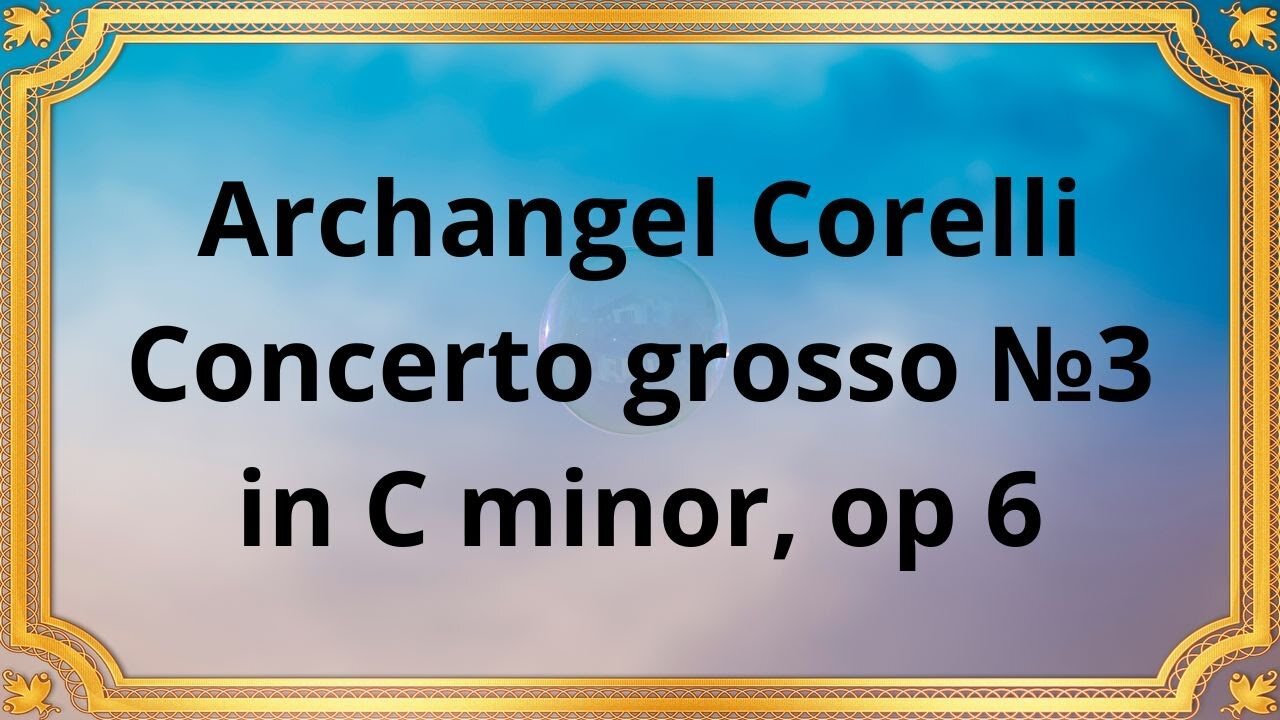Premium Only Content

Archangel Corelli Concerto grosso №3 in C minor, op 6
#ClassicalMusic #MusicalComposition #ArchangelCorelli #ConcertoGrosso #CMinor #Opus6 #BaroqueMusic #ItalianComposer #StringInstruments #ContrastingMusicalGroups
Orchestre de chambre Janacek, direction: Z. Dejmek
Arcangelo Corelli's Concerto Grosso No. 3 in C minor, Op. 6, is a remarkable musical composition that exemplifies the brilliance of the Baroque era. This work, composed in the late 17th century, showcases Corelli's mastery of the concerto grosso form, highlighting the contrast between a small group of soloists and the larger ensemble.
Arcangelo Corelli, an Italian composer and violinist, played a pivotal role in the development of the Baroque concerto grosso. Composed around 1680, Concerto Grosso No. 3 in C minor was part of Corelli's Opus 6 collection, which became one of the most influential sets of concertos in the Baroque period. Corelli's innovative approach to the concerto grosso form inspired many composers who followed.
The Concerto Grosso No. 3 in C minor showcases Corelli's skillful interplay between two contrasting musical groups: the concertino, consisting of two violins and a cello, and the ripieno, the larger ensemble of strings and continuo. This composition is structured in four movements, each with its distinct character and mood.
The opening movement, marked "Largo," sets a dramatic and melancholic tone. It features a poignant melody played by the concertino, which is then echoed by the ripieno. This movement establishes the groundwork for the contrasting musical forces that define the concerto grosso.
The second movement, "Allegro," introduces a lively and energetic atmosphere. It showcases Corelli's mastery of counterpoint and virtuosic violin writing, with the soloists engaging in dialogue with the ripieno. The interplay between the two groups creates a dynamic and engaging musical conversation.
The third movement, "Adagio," contrasts with the previous movement, presenting a slower and more introspective character. The concertino takes center stage, weaving a delicate and expressive melody that is accompanied by the ripieno. This movement showcases Corelli's ability to evoke deep emotion and introspection through his compositions.
The final movement, "Allegro," returns to a lively and spirited tempo, bringing the concerto to a triumphant conclusion. It features intricate melodic passages and a joyful interplay between the concertino and the ripieno, creating a sense of celebration and resolution.
Arcangelo Corelli's Concerto Grosso No. 3 in C minor, Op. 6, has left an indelible mark on the development of the concerto grosso form. Corelli's innovative use of contrasting musical groups and his intricate melodic writing influenced composers such as Handel, Vivaldi, and Bach. His Opus 6 collection, including this concerto, became a cornerstone of Baroque music and a source of inspiration for generations of musicians.
Arcangelo Corelli's Concerto Grosso No. 3 in C minor, Op. 6, stands as a testament to the composer's mastery of the concerto grosso form and his ability to create contrasting musical brilliance. Its innovative structure and interplay between the concertino and ripieno showcase Corelli's skillful composition and his profound understanding of musical expression. This remarkable work has left an enduring legacy in the world of Baroque music, inspiring composers and captivating audiences with its contrasting moods, virtuosic violin passages, and overall musical brilliance.
You have the opportunity to support the channel:
https://destream.net/live/RadSiarAl/donate
https://www.buymeacoffee.com/6355radsiaral
-
 20:26
20:26
Classical music_Music Inspiration
1 month agoJohann Sebastian Bach Orchestral Suite No. 2 in B minor, BWV 1066
862 -
 LIVE
LIVE
Anthony Rogers
1 day agoEpisode 376 - Todd Schowalter
35 watching -
 LIVE
LIVE
megimu32
1 hour agoOTS: Movie Tie-In Games + Remakes: Let’s Play Memory Lane
61 watching -
 LIVE
LIVE
Adam Does Movies
9 hours agoTalking Movies + Ask Me Anything - LIVE
63 watching -
 1:17:18
1:17:18
Glenn Greenwald
1 day agoWhat are CBS News' Billionaire Heirs Doing with Bari Weiss? With Ryan Grim on the Funding Behind It; Europe Capitulates to Trump Again | SYSTEM UPDATE #494
83.3K31 -
 1:43:49
1:43:49
RiftTV
3 hours agoCNN Calls Black NY Shooter WHITE, Cincinnati FATIGUE | The Rift | Guest: Braeden Sorbo, 2Protects1
22.8K10 -
 4:21:04
4:21:04
LumpyPotatoX2
4 hours agoKilling Floor 3: Rampage & Chaos - #RumbleGaming
2.33K -
 LIVE
LIVE
BrancoFXDC
4 hours agoPlaying Ranked Warzone - Pursuit of Diamond Rank
60 watching -
 1:11:41
1:11:41
Omar Elattar
4 hours agoThe Brain Experts: "Your Overthinking Problem Has A Physical Solution & We Can Show You!"
6.92K1 -
 LIVE
LIVE
Mattnifico
3 hours agoREPLAYING EVERY FORZA HORIZON GAME - Forza Horizon 1 (Part 2)
20 watching